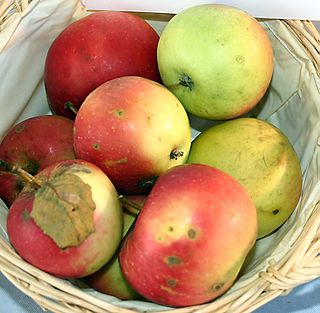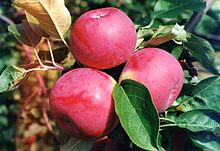
The McIntosh, McIntosh Red, or colloquially the Mac, is an apple cultivar, the national apple of Canada. The fruit has red and green skin, a tart flavour, and tender white flesh, which ripens in late September. In the 20th century it was the most popular cultivar in Eastern Canada and New England, and is considered an all-purpose apple, suitable both for cooking and eating raw.

Malus is a genus of about 30–55 species of small deciduous trees or shrubs in the family Rosaceae, including the domesticated orchard apple, crab apples and wild apples.

Apple cider is the name used in the United States and Canada for an unfiltered, unsweetened, non-alcoholic beverage made from apples. Though typically referred to simply as "cider" in the United States, it is not to be confused with the alcoholic beverage known as cider in other places, which is called "hard cider" in the US. Outside of the United States and Canada, it is commonly referred to as cloudy apple juice to distinguish it from clearer, filtered apple juice and hard cider.

Cider apples are a group of apple cultivars grown for their use in the production of cider. Cider apples are distinguished from "cookers" and "eaters", or dessert apples, by their bitterness or dryness of flavour, qualities which make the fruit unpalatable but can be useful in cidermaking. Some apples are considered to occupy more than one category.

A cooking apple or culinary apple is an apple that is used primarily for cooking, as opposed to a dessert apple, which is eaten raw. Cooking apples are generally larger, and can be tarter than dessert varieties. Some varieties have a firm flesh that does not break down much when cooked. Culinary varieties with a high acid content produce froth when cooked, which is desirable for some recipes. Britain grows a large range of apples specifically for cooking. Worldwide, dual-purpose varieties are more widely grown.

Cortland is a cultivar of apple developed at the New York State Agricultural Experiment Station in Geneva, New York, United States in 1898. The apple was named after nearby Cortland County, New York. It is among the fifteen most popular in the United States and Canada.

The Braeburn is a cultivar of apple that is firm to the touch with a red/orange vertical streaky appearance on a yellow/green background. Its color intensity varies with different growing conditions.

Honeycrisp is an apple cultivar developed at the Minnesota Agricultural Experiment Station's Horticultural Research Center at the University of Minnesota, Twin Cities. Designated in 1974 with the MN 1711 test designation, patented in 1988, and released in 1991, the Honeycrisp, once slated to be discarded, has rapidly become a prized commercial commodity, as its sweetness, firmness, and tartness make it an ideal apple for eating raw. "...The apple wasn't bred to grow, store or ship well. It was bred for taste: crisp, with balanced sweetness and acidity." It has larger cells than most apple cultivars, a trait which is correlated with juiciness, as theoretically a higher number of cells rupture when bitten, releasing more juice in the mouth. The Honeycrisp also retains its pigment well and has a relatively long shelf life when stored in cool, dry conditions. Pepin Heights Orchards delivered the first Honeycrisp apples to grocery stores in 1997. The name Honeycrisp was trademarked by the University of Minnesota, but university officials were unsure of its protection status in 2007. It is now the official state fruit of Minnesota. A large-sized honeycrisp will contain about 113 calories.
John McIntosh was a Scottish-Canadian farmer and fruit breeder, credited with discovering the McIntosh Red apple. Through the apple, his surname is the eponym of the Macintosh computers and operating systems by Apple Inc.

The Jonathan apple is a medium-sized sweet apple, with a touch of acid and a tough but smooth skin. It is closely related to the Esopus Spitzenburg apple, good for eating fresh and for cooking. Sugar 14%, acid 9g/litre, vitamin C 5mg/100g.

Christine Hewitt is a fictional character from the BBC soap opera EastEnders, played by Elizabeth Power. Introduced in 1992 as a lonely divorcée, she becomes besotted with married Arthur Fowler while he tends her garden. She leaves in 1993 once her affair with Arthur is discovered by his wife Pauline.

Ginger Gold is a yellow apple variety which entered commerce in the 1980s, though the original seedling dates from the late 1960s. According to the US Apple Association website, as of 2008, it was one of the fifteen most popular apple cultivars in the United States.

'Ambrosia' is a cultivar of apple originating in British Columbia, Canada in the early 1990s. The original tree was first cultivated by the Mennell family of Similkameen Valley, British Columbia, who discovered it growing in their orchard.

Empire is the name of a clonally propagated cultivar of apple derived from a seed grown in 1945 by Lester C. Anderson, a Cornell University fruit nutritionist who conducted open pollination research on his various orchards. In 1945, under the direction of A. J. Heinicke, scientists from the New York State Agricultural Experiment Station of Cornell University in Geneva, New York, harvested the Empire seed together with thousands of its siblings. The Geneva teams grew and tested ever dwindling sub-populations of the sibling group until 1966, when the final selection, the Empire, was released to the public at the New York Fruit Testing Association meetings in Geneva. According to the US Apple Association website it is one of the fifteen most popular apple cultivars in the United States.

Gymnosporangium juniperi-virginianae is a plant pathogen that causes cedar-apple rust. In virtually any location where apples or crabapples (Malus) and Eastern red cedar coexist, cedar apple rust can be a destructive or disfiguring disease on both the apples and cedars. Apples, crabapples, and eastern red cedar are the most common hosts for this disease. Similar diseases can be found on Quince and hawthorn and many species of juniper can substitute for the eastern red cedars.

The origins of the Rambo apple cultivar are unknown. It may date back to the American colony of New Sweden, when in 1637 Peter Gunnarsson Rambo, a Swedish immigrant, arrived on the Kalmar Nyckel. Swedish natural historian Pehr Kalm, who wrote Travels in North America, 1747–51, took notes of his interview with Mr. Peter Rambo, grandson of Peter Gunnarsson Rambo, recording that the "original Peter Rambo had brought apple seeds and several other tree and garden seeds with him in a box." The first Rambo apple tree was very likely grown from one of these seeds. There is no certainty, however, since the earliest documented mention of the apple variety's origin occurs in William Coxe's A View of the Cultivation of Fruit Trees, and the Management of Orchards and Cider, published in 1817. Coxe wrote only that the Rambo was much cultivated in Delaware, Pennsylvania, and New Jersey and took "its name from the families by whom it was introduced into notice."

An apple is an edible fruit produced by an apple tree. Apple trees are cultivated worldwide and are the most widely grown species in the genus Malus. The tree originated in Central Asia, where its wild ancestor, Malus sieversii, is still found. Apples have been grown for thousands of years in Asia and Europe and were brought to North America by European colonists. Apples have religious and mythological significance in many cultures, including Norse, Greek, and European Christian tradition.

The 'York Imperial', or 'York', is a cultivar of apple from which a number of other valuable strains and cultivars have arisen, including four sport varieties: Commander York, Ramey York, Red Yorking, and Yorking.

The Foxwhelp is a very old cider apple cultivar, originating in the west Midlands of England.

Melba is a Canadian cultivar of domesticated apple, which was developed by W. T. Macoun at the Central Experimental Farm, in Ottawa, Ontario by crossing a McIntosh with a Liveland Raspberry apple. It has a yellow skin washed with crimson colour. Flesh is extremely white, firm and crisp. Flavor is sweet with hints of tart. There is also a Red Melba mutation which is more red coloured, and is ripening later in season.



















